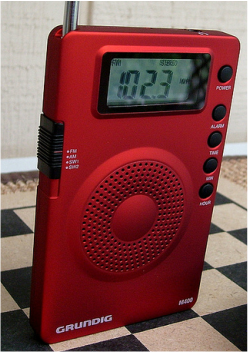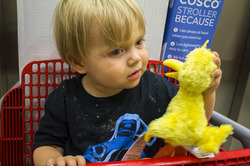
In this day of entire television networks designed for babies and millions, probably billions, of dollars' worth of toys designed to stimulate their brain growth, all kids really need is to do is play with you. The very nature of interacting with you is where the action is. While they benefit from playing with a variety of toys, listening to your language, watching your hands and your facial expressions is the bulk of the benefit.

When you help them stack blocks and you say, "The biggest yellow one is first, then the smaller blue one is second and the smallest red one is third", you are giving them a world of information. You are teaching color, size and ordinal counting. Wow. Sequencing is born. If you roll the ball, but the cube doesn't roll, they have the chance to observe the properties of the reasons behind those actions. In the natural world, things that are round roll and things that are square don't roll quite so easily. Ta da!
They learn fine motor skills and begin to train their visual perceptual systems. They learn to coordinate their body movements in order to reach the ball.
Rapport between parent and child begins to take shape as the interactions encourage patience and understanding. Bonding is intense during this time and baby may not be able to tolerate extended periods of this intensity, so spread the play times out over the course of the day.
Babies and young children learn to approach tasks in different ways which is critical for "cognitive flexibility" and adaptation. If they can't do it one way, show them another. They'll develop a rich menu of alternatives to get any job done if you teach them "how" to think.

They make the connections through the experiences that you provide them. Sitting them in front of the television cannot duplicate this interaction and it cannot duplicate the kinds of learning that takes place.
When you play with them and offer language and many opportunities to observe the blocks tumbling again and again and you are bored out of your mind, just watch your baby. They delight in the predictability of what you are doing. Every time those blocks fall, they are making the connection between the "what" and the "why" of it all. They learn the predict what will happen. When they get bored with it, it's time to move on. They have become "saturated" with the activity for now....
| Playing involves both external and internal language. Internal language is thought and thought requires vocabulary. When you interact with your children, you label and describe which expands their word knowledge. They learn concepts such as same and different. They learn to categorize and classify. This baby is reaching out to his dad's mouth to experience everything he can about the communication. His eyes are directly fixed on his dad's face and this is where baby learns prosody or the rhythm of language and make connections between the sounds of language and the associated facial expressions. Very powerful, indeed. |
Oh, and as for those wonderful bouncy "loungers" where babies spend a great deal of time, limit that, too. Babies need to be on their tummies to give them another view of the world and to increase their neck and core body strength. If they don't have strength, they won't learn to crawl competently. Crawling is critical. Research (and frankly, the 23 years' worth of experience that I've had in private practice) reveals that babies who don't crawl are more vulnerable to learning and developmental problems than the babies who are competent crawlers!
TTFN, Claudia





